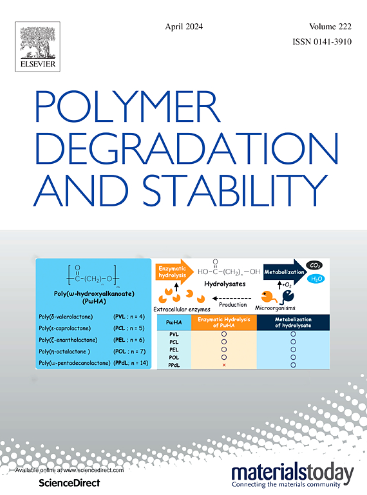聚丙烯基体的重复热塑性加工对低分子量化合物生成的影响
IF 6.3
2区 化学
Q1 POLYMER SCIENCE
引用次数: 0
摘要
本研究探讨了重复再加工对聚丙烯(PP)的影响以及相关的低分子量物质释放到液相和气相。具体来说,将未加工聚丙烯(Mosten TB 003)进行机械再加工1,5,10,15和18次,以模拟其参与机械回收循环。评估了所有PP样品的力学性能,以及它们在水中的潜在迁移。通过差示扫描量热法(DSC)评估PP的稳定性,通过高温凝胶渗透色谱法(GPC)通过折射和粘度检测来确定分子量分布。GPC和DSC的力学性能分析表明,再加工导致链缩短和热稳定性降低,材料变黄证明。对于回收18次的PP(代表最大可行的再加工循环次数),与原始PP相比,分子量减少了约30%。使用顶空固相微萃取(HS-SPME)结合气相色谱-质谱(GC-MS)监测PP加工过程中挥发性物质(气味剂)释放到环境中的潜在情况。研究了两种提取温度:90°C,模拟PP在室内达到的最高温度,120°C,代表室外条件。在最广泛再加工的PP (18x)中检测到的挥发性物质最少。在120°C下,鉴定出的最重要的化合物包括酚类物质,如2,4-二叔丁基苯酚、2,6-二叔丁基对苯醌、4-羟基苯甲醛、雌二醇和2-苯氧乙醇。4-甲基-1,6-庚二烯-4-醇的存在表明了后处理循环的次数。本文章由计算机程序翻译,如有差异,请以英文原文为准。
Effect of repeated thermoplastic processing of polypropylene matrix on the generation of low-molecular-weight compounds
This study investigates the effects of repeated reprocessing on polypropylene (PP) and the associated release of low-molecular-weight substances into liquid and gaseous phases. Specifically, virgin polypropylene (Mosten TB 003) was mechanically reprocessed 1, 5, 10, 15, and 18 times to simulate its participation in the mechanical recycling cycle. The mechanical properties of all PP samples were evaluated, along with their potential migration into water. The stability of PP was assessed using differential scanning calorimetry (DSC), while molecular weight distribution was determined via high-temperature gel permeation chromatography (GPC) with refractometric and viscosimetric detection. GPC and DSC analyses of PP's mechanical properties revealed that reprocessing led to chain shortening and reduced thermal stability, evidenced by material yellowing. For PP recycled 18 times—representing the maximum feasible number of reprocessing cycles—the molecular weight decreased by approximately 30 % compared to virgin PP. The potential release of volatile substances (odorants) into the environment during PP processing was monitored using headspace solid-phase microextraction (HS-SPME) combined with gas chromatography-mass spectrometry (GC–MS). Two extraction temperatures were examined: 90 °C, simulating the maximum temperature PP reaches indoors, and 120 °C, representing outdoor conditions. The least volatile substances were detected in the most extensively reprocessed PP (18x). At 120 °C, the most significant compounds identified included phenolic substances such as 2,4-di‑tert-butylphenol, 2,6-di‑tert‑butyl‑p-benzoquinone, 4-hydroxybenzaldehyde, estragole, and 2-phenoxyethanol. The number of reprocessing cycles was indicated by the presence of 4-methyl-1,6-heptadien-4-ol.
求助全文
通过发布文献求助,成功后即可免费获取论文全文。
去求助
来源期刊

Polymer Degradation and Stability
化学-高分子科学
CiteScore
10.10
自引率
10.20%
发文量
325
审稿时长
23 days
期刊介绍:
Polymer Degradation and Stability deals with the degradation reactions and their control which are a major preoccupation of practitioners of the many and diverse aspects of modern polymer technology.
Deteriorative reactions occur during processing, when polymers are subjected to heat, oxygen and mechanical stress, and during the useful life of the materials when oxygen and sunlight are the most important degradative agencies. In more specialised applications, degradation may be induced by high energy radiation, ozone, atmospheric pollutants, mechanical stress, biological action, hydrolysis and many other influences. The mechanisms of these reactions and stabilisation processes must be understood if the technology and application of polymers are to continue to advance. The reporting of investigations of this kind is therefore a major function of this journal.
However there are also new developments in polymer technology in which degradation processes find positive applications. For example, photodegradable plastics are now available, the recycling of polymeric products will become increasingly important, degradation and combustion studies are involved in the definition of the fire hazards which are associated with polymeric materials and the microelectronics industry is vitally dependent upon polymer degradation in the manufacture of its circuitry. Polymer properties may also be improved by processes like curing and grafting, the chemistry of which can be closely related to that which causes physical deterioration in other circumstances.
 求助内容:
求助内容: 应助结果提醒方式:
应助结果提醒方式:


